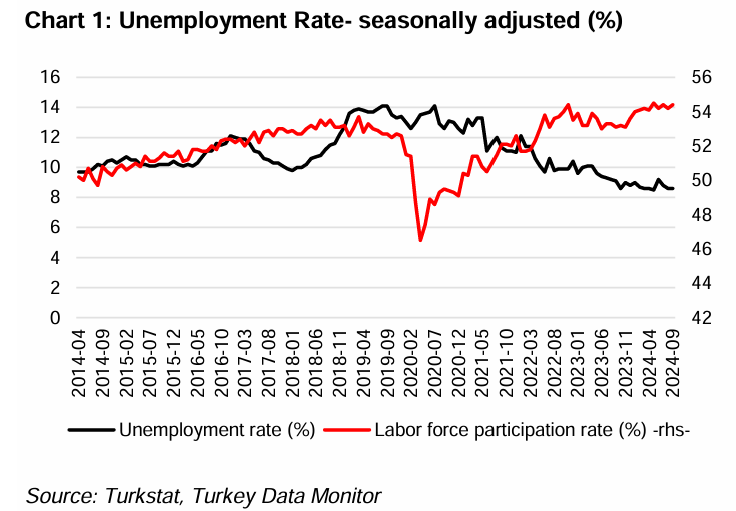Unemployment rate materialized at 8.6%…
Unemployment rate in September remained unchanged at 8.6% compared to a month ago, while declining by 0.5pps on an annual basis. The unemployment rate not adjusted for seasonality came in at 8.6% in September, corresponding 0.3pps improvement compared to the last year.

The number of unemployed, which decreased by 89K in the previous month, rose in September by 35K m/m to 3.10 million. The number of employed, in the meanwhile, rose by 95K m/m to 32.82 million. In addition, labor force increased by 131K m/m to 35.92 million.
Accordingly, the seasonally adjusted labor force participation rate rose to 54.4% from 54.2% a month ago. Female labor force participation, a crucial driver of long-term economic development, rose all-time high of 37.0% can be attributable depressed wages and the record-low male unemployment rate. Despite the slowdown in business activity, employment has remained relatively robust in headline figures. However, this trend is not likely to continue in the upcoming period.
Male unemployment rate is at all time low…
Female employment declined by 8K in September, while the female unemployment rate rose significantly to 12.3% from 11.6% a month earlier, slightly above the 12-month average of 11.8%. The main driver of the increase in the unemployment rate was an 85K rise in labor force participation. On the flip side, male employment increased by 104K, while male unemployment fell all-time low of 6.7% in September, despite 46K rise in labour force.
Meanwhile, the youth unemployment rate, which covers the 15-24 age group, rose to 17.1% from 16.8% in August. Monthly employment gain was 49K in September, while labour force soared by 79K.
Average working hours remained depressed…
Weekly working hours in September remained unchanged at 42.7, while falling by 1.5 hours on an annual basis. This is lower than 44.2 hours average of the 2023, signaling employment is likely to get weaken in the upcoming period. On the other hand, the labor underutilization rate (the broad measure of employment) fell by 1.7 pps m/m, yet rose by 3.8 pps y/y to 25.6%, staying above the five-year average of 23.6%. The high course in labour underutilization can be attributable to the employment of women who joined the labour force due to financial difficulties or retirees after YET (early retirement) law.
By TSKB
Follow our English language YouTube videos @ REAL TURKEY: https://www.youtube.com/channel/UCKpFJB4GFiNkhmpVZQ_d9Rg
And content at Twitter: @AtillaEng
Facebook: Real Turkey Channel: https://www.facebook.com/realturkeychannel/
